南方医科大学学报 ›› 2025, Vol. 45 ›› Issue (8): 1633-1642.doi: 10.12122/j.issn.1673-4254.2025.08.08
• • 上一篇
邓楚玉1( ), 王雪莹1, 甘立祥1, 王大禹1, 郑晓燕2, 唐纯志1(
), 王雪莹1, 甘立祥1, 王大禹1, 郑晓燕2, 唐纯志1( )
)
收稿日期:2025-02-08
出版日期:2025-08-20
发布日期:2025-09-05
通讯作者:
唐纯志
E-mail:tanyacyd@163.com;jordan664@163.com
作者简介:邓楚玉,在读博士研究生,E-mail: tanyacyd@163.com
基金资助:
Chuyu DENG1( ), Xueying WANG1, Lixiang GAN1, Dayu WANG1, Xiaoyan ZHENG2, Chunzhi TANG1(
), Xueying WANG1, Lixiang GAN1, Dayu WANG1, Xiaoyan ZHENG2, Chunzhi TANG1( )
)
Received:2025-02-08
Online:2025-08-20
Published:2025-09-05
Contact:
Chunzhi TANG
E-mail:tanyacyd@163.com;jordan664@163.com
Supported by:摘要:
目的 观察电针足三里对高脂饮食(HFD)诱导的高脂血症小鼠的疗效,探讨其作用机制。 方法 普通饮食C57BL/6J小鼠作为对照组(ND), 高脂模型小鼠随机分为高脂饮食组(HFD组)、高脂饮食+电针足三里组(EA组),10只/组,EA组予电针足三里穴,记录3组小鼠在高脂饮食造模和针刺干预期间的体质量变化,干预16周后评估各组小鼠血脂4项(TC、TG、LDL-c、HDL-c)和血清丙二醛(MDA)含量;油红O染色观察肝脏形态学变化及脂质蓄积情况;Western blotting检测各组小鼠结肠组织中NLRP3、TLR4、IL-1b蛋白表达的影响;采用16S rRNA基因测序检测各组小鼠肠道菌群组成结构及相对丰度。 结果 干预16周,与HFD组比较,EA组小鼠体质量、血清TC、TG、LDL-C含量降低(P<0.01),MDA含量降低(P<0.05);油红O染色结果表明,与ND相比,HFD组可见肝脏组织脂滴蓄积,脂滴明显升高,与HFD组相比,EA组小鼠肝脏的脂滴减少(P<0.05);Western blotting显示与对照组相比,模型组小鼠结肠组织中NLRP3、TLR4、IL-1β蛋白表达均升高(P<0.05或P<0.01);而与对照组相比,电针组小鼠结肠组织中NLRP3、TLR4、IL-1β蛋白表达差异无统计学意义(P>0.05);与模型组相比,电针组小鼠结肠组织中NLRP3蛋白的表达降低(P<0.05)。16S rRNA测序表明EA治疗后肠道菌群数量明显回升(P<0.05),Muribaculaceae菌和Lachnospiraceae_NK4A136_group菌相对丰度升高(P<0.05)。 结论 电针足三里可能通过改善肠道菌群结构,增加Muribaculaceae属菌的丰度、促进降解高热量复合碳水化合物、改善胆固醇脂质代谢,并增加Lachnospiraceae_NK4A136_group菌而修复肠道黏膜、减轻毒素泄露,减少脂质过氧化物,减少肝脏脂肪沉积,降低高脂血症动物肠道黏膜NLRP3、TLR4、IL-1β的含量,减轻肠黏膜炎症,维护肠道屏障完整,改善血脂紊乱,为解释足三里的降脂作用提供了新的见解和实验依据。
邓楚玉, 王雪莹, 甘立祥, 王大禹, 郑晓燕, 唐纯志. 电针足三里改善高脂血症小鼠的血脂紊乱:基于肠道菌群结构的改善[J]. 南方医科大学学报, 2025, 45(8): 1633-1642.
Chuyu DENG, Xueying WANG, Lixiang GAN, Dayu WANG, Xiaoyan ZHENG, Chunzhi TANG. Electroacupuncture at Zusanli improves blood lipid disorders in hyperlipidemic mice by improving gut microbiota structure[J]. Journal of Southern Medical University, 2025, 45(8): 1633-1642.
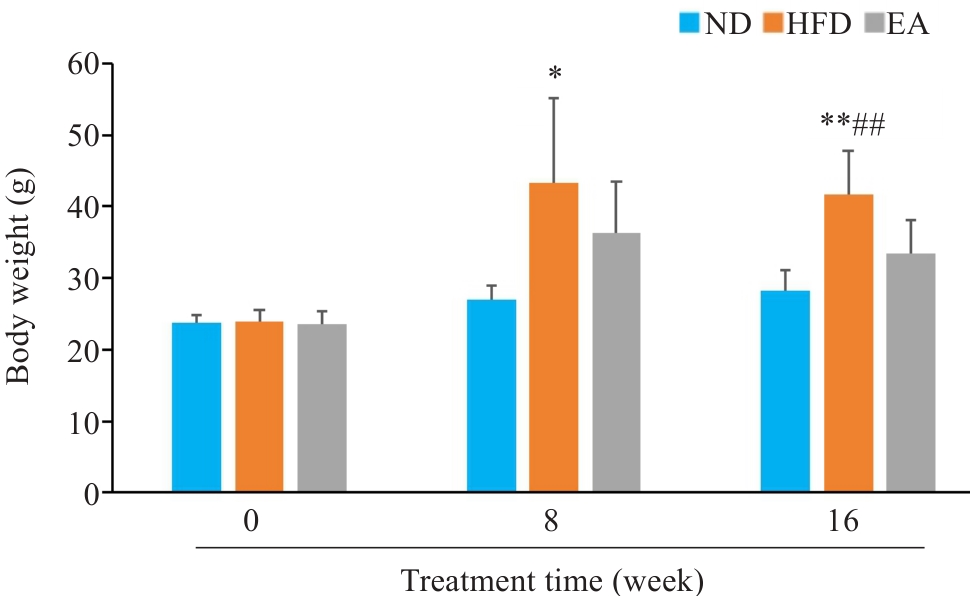
图2 各组小鼠8周及16周体质量变化
Fig.2 Weight changes of the mice in each group at 8 and 16 weeks (Mean±SD, n=10). *P<0.05, **P<0.01vs ND, ##P<0.01 vs EA. ND:Normal diet group; HFD: High fat diet group; EA: High fat diet and electroacupuncture group.
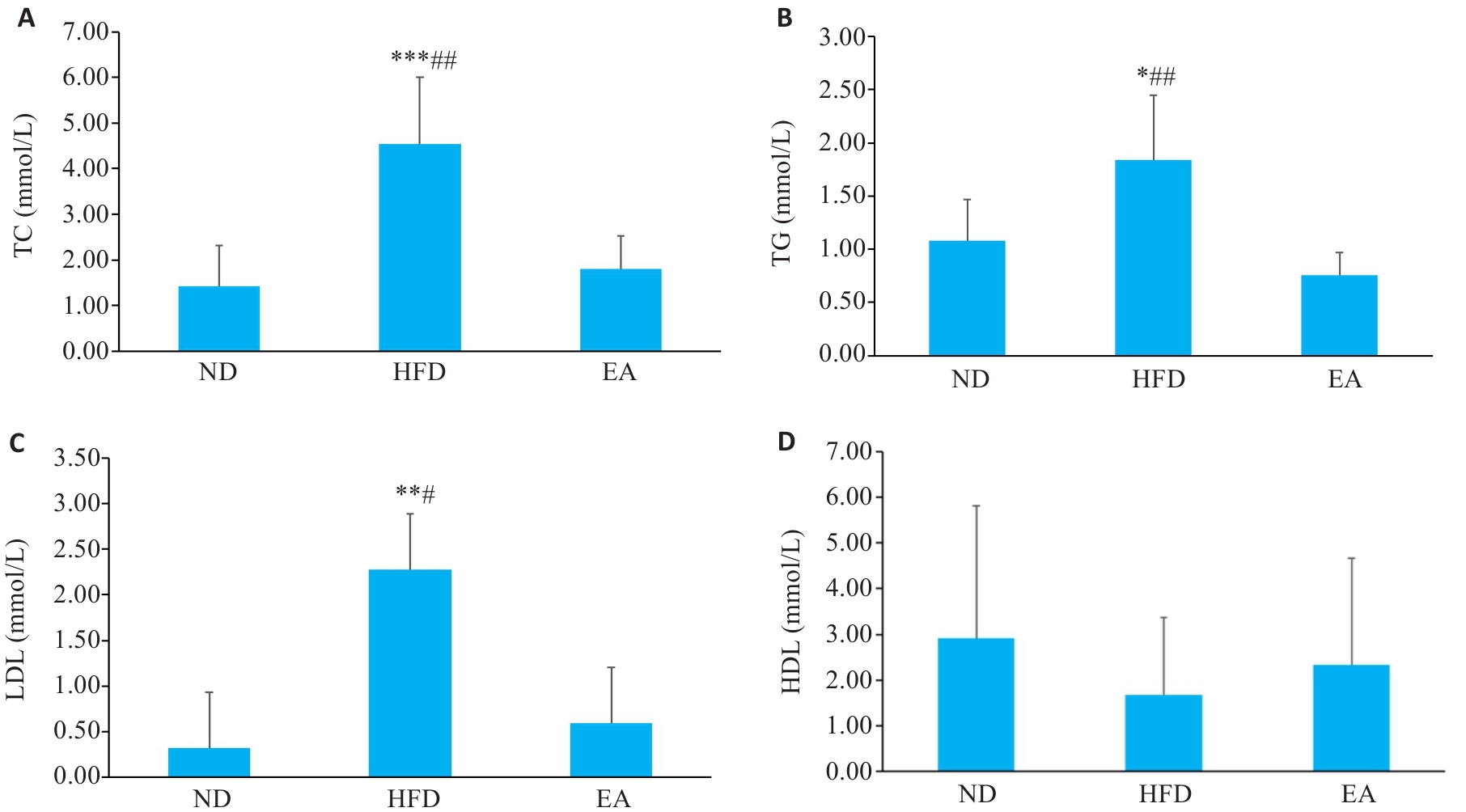
图3 各组小鼠血脂结果比较
Fig.3 Comparison of TC (A), TG (B), LDL-c (C) and HDL-c (D) levels of the mice among the groups (Mean±SD, n=6). *P<0.05, **P<0.01, ***P<0.001 vs ND, #P<0.05, ##P<0.01 vs EA. ND:Normal diet group; HFD: High fat diet group; EA: High fat diet and electroacupuncture group.
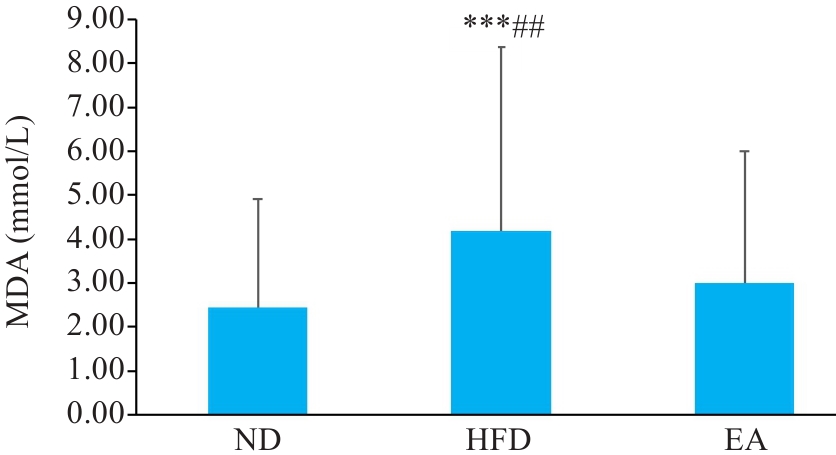
图4 各组小鼠血清MDA比较
Fig.4 Comparison of serum MDA levels of the mice among the 3 groups (Mean±SD, n=6). ***P<0.001 vs ND, ##P<0.01 vs EA. ND: Normal diet group; HFD: High fat diet group; EA: High fat diet and electroacupuncture group.
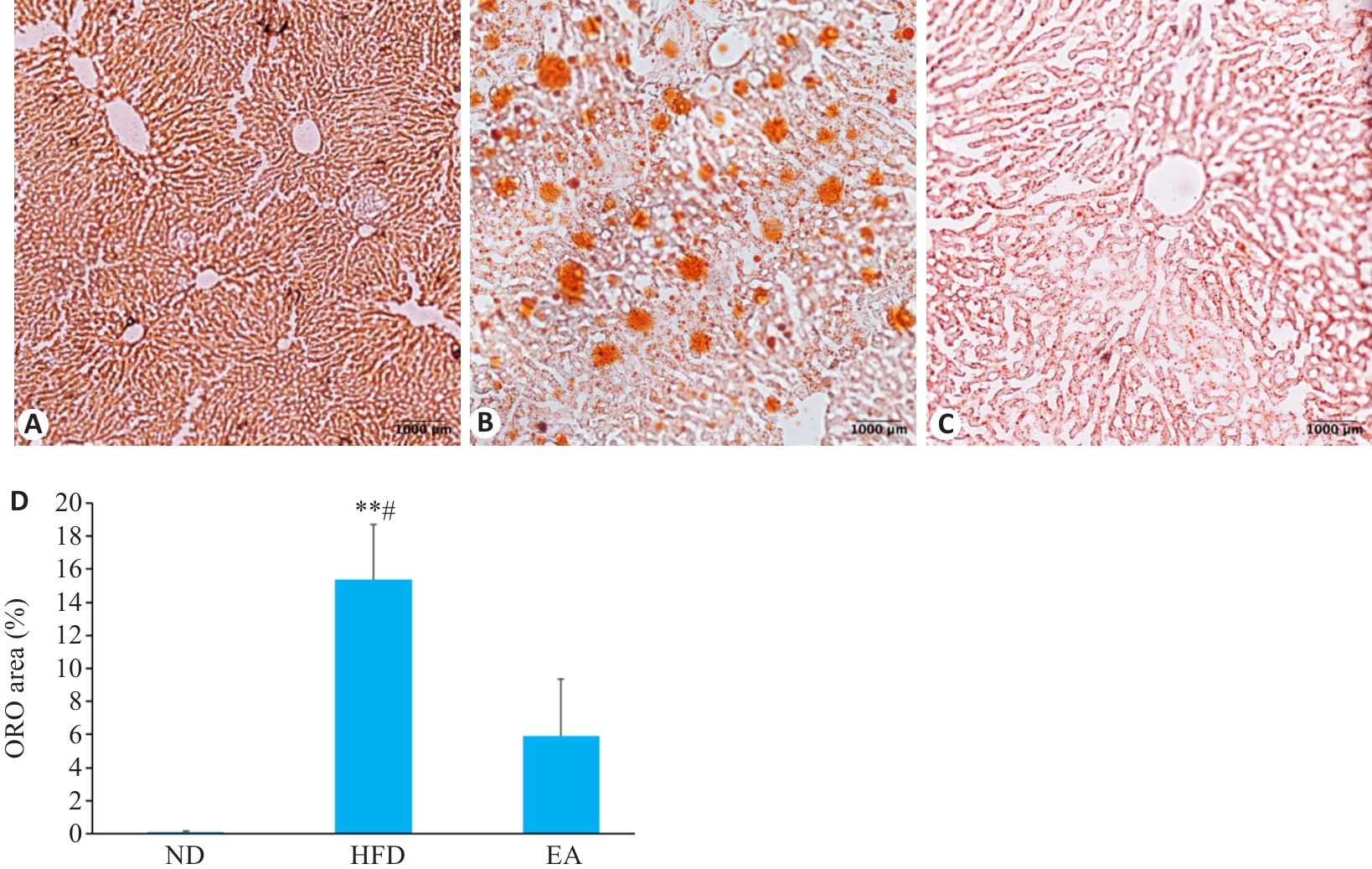
图5 电针足三里对高脂血症小鼠肝脏脂滴蓄积的影响
Fig.5 Lipid droplet accumulation in the liver of the mice (Oil Red Staining,Scale=1000 μm). A: ND group. B: HFD group. C: EA group. D: Comparison of Oil Red O stained area (%) among the 3 groups (Mean±SD, n=3). **P<0.01vs ND, #P<0.05 vs EA group. ND: Normal diet group; HFD: High fat diet group; EA: High fat diet and electroacupuncture group.
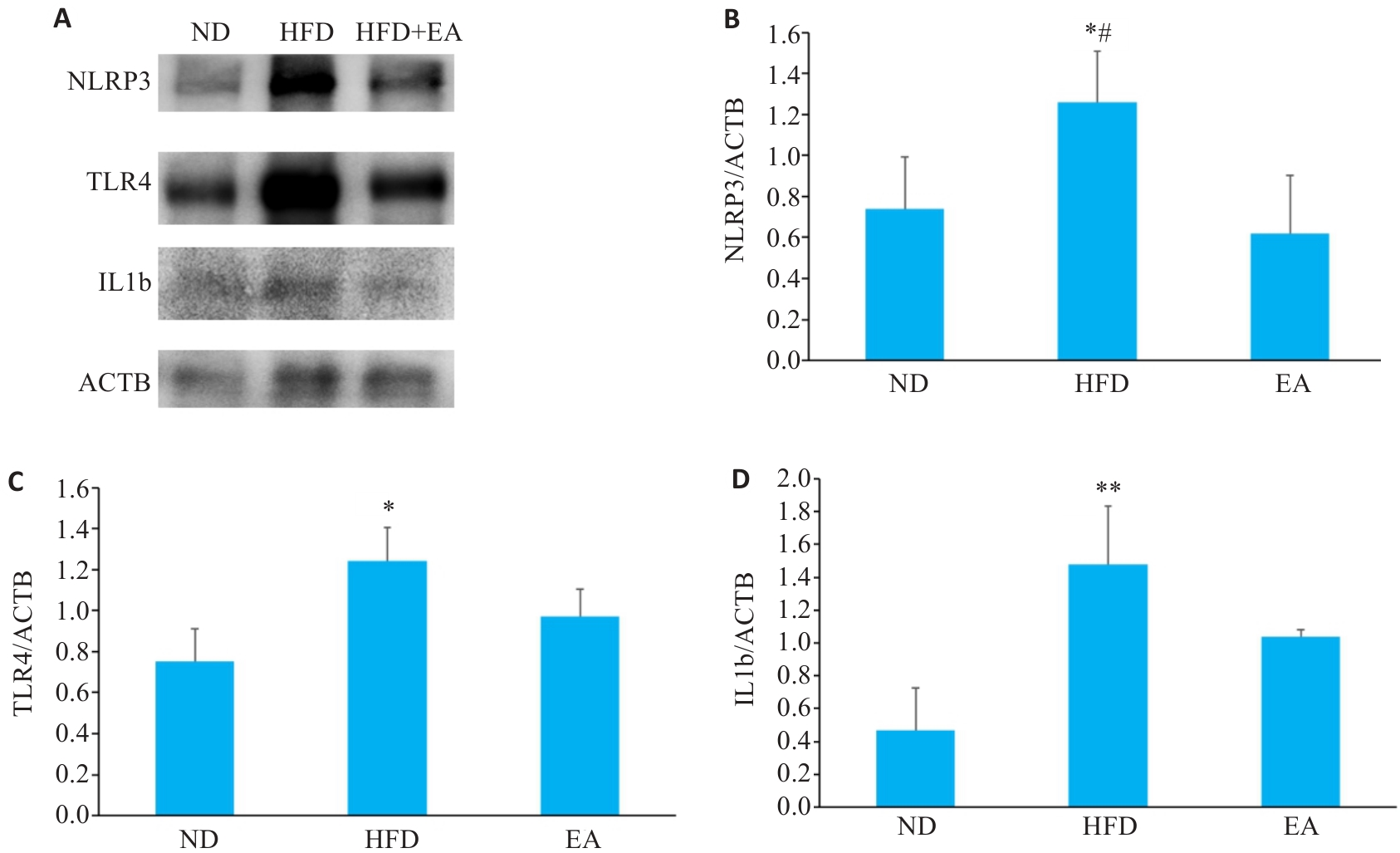
图6 Western blotting分析小鼠结肠NLRP3、TLR4、IL-1b炎症相关蛋白表达
Fig.6 NLRP3, TLR4 and IL-1b protein expressions in mouse colon tissues detected by Western blotting (Mean±SD, n=4). A: Protein band of NLRP3, TLR4 and IL-1b. B-D: Bar chart of gray scale values of the protein bands. *P<0.05, **P<0.01vs ND group; #P<0.05 vs EA group. ND: Normal diet group; HFD: High fat diet group; EA: High fat diet and electroacupuncture group.
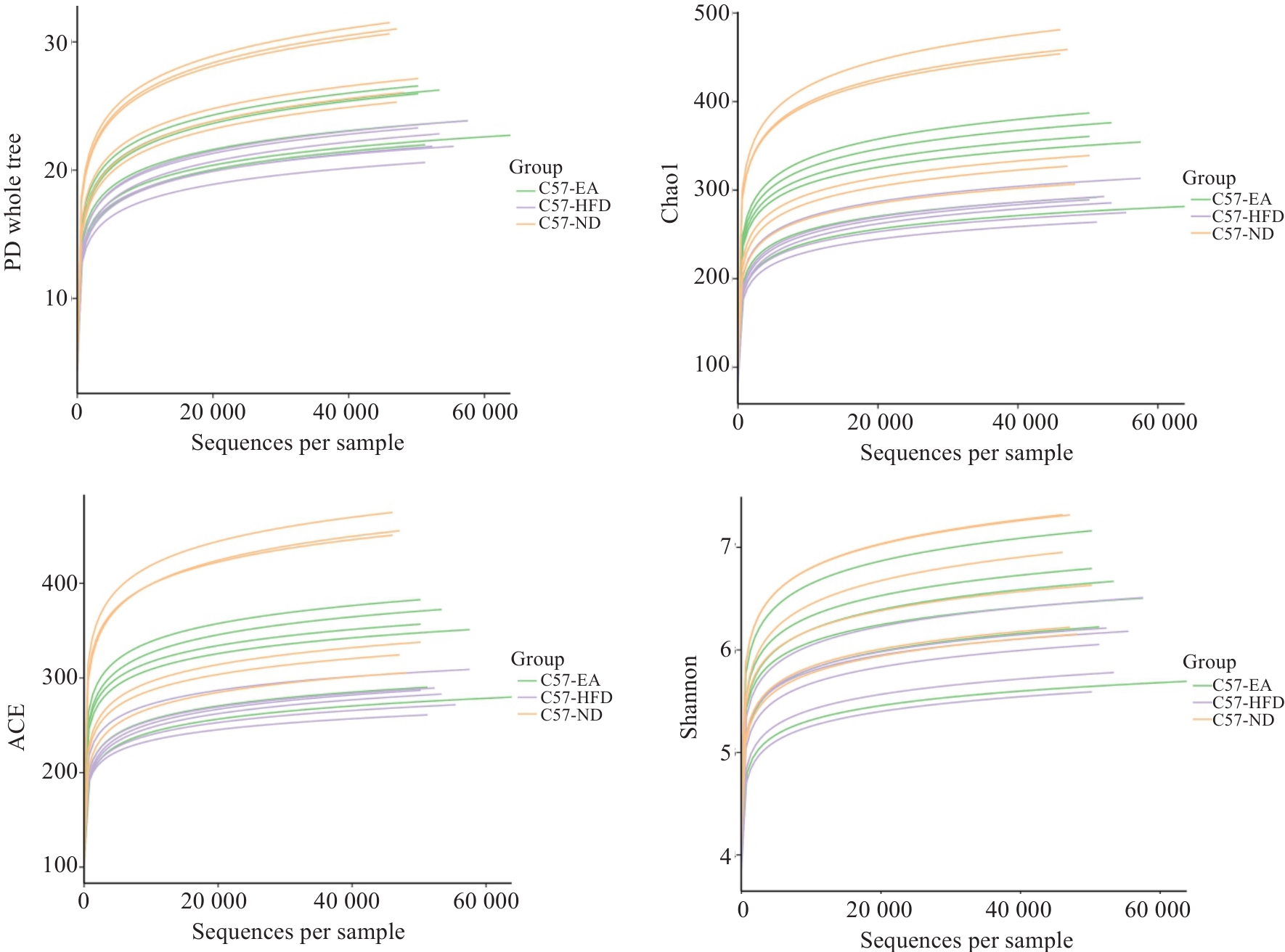
图7 ASV 以及多样性指数稀释曲线
Fig.7 ASV and diversity index dilution curve in the 3 groups. ND: Normal diet group; HFD: High fat diet group; EA: High fat diet and electroacupuncture group.
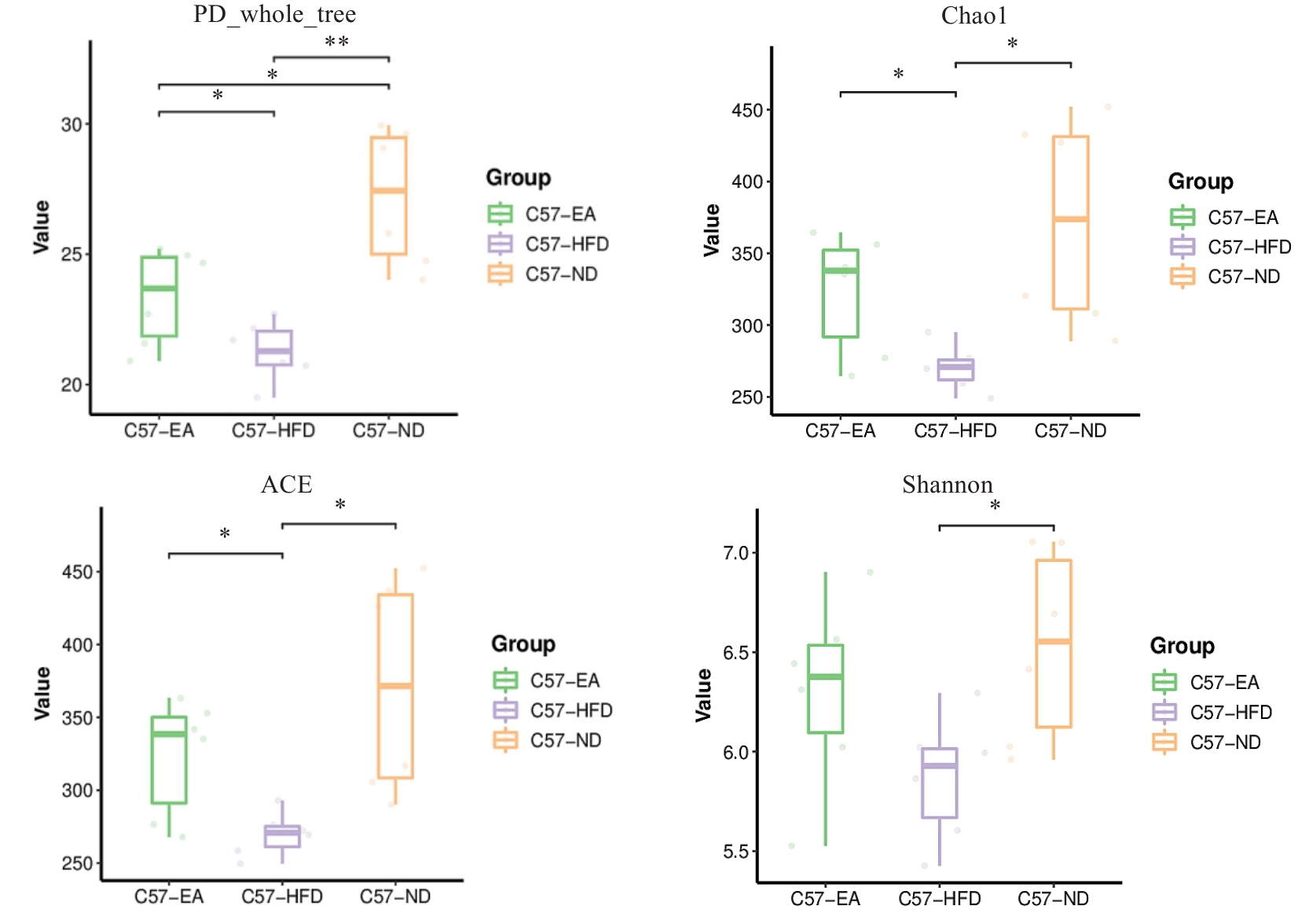
图8 ASV 多样性指数组间比较 Boxplot 图
Fig.8 Fig.8 Alpha diversity related boxplot. *P<0.05, **P<0.01. ND: Normal diet group; HFD: High fat diet group; EA: High fat diet and electroacupuncture group.
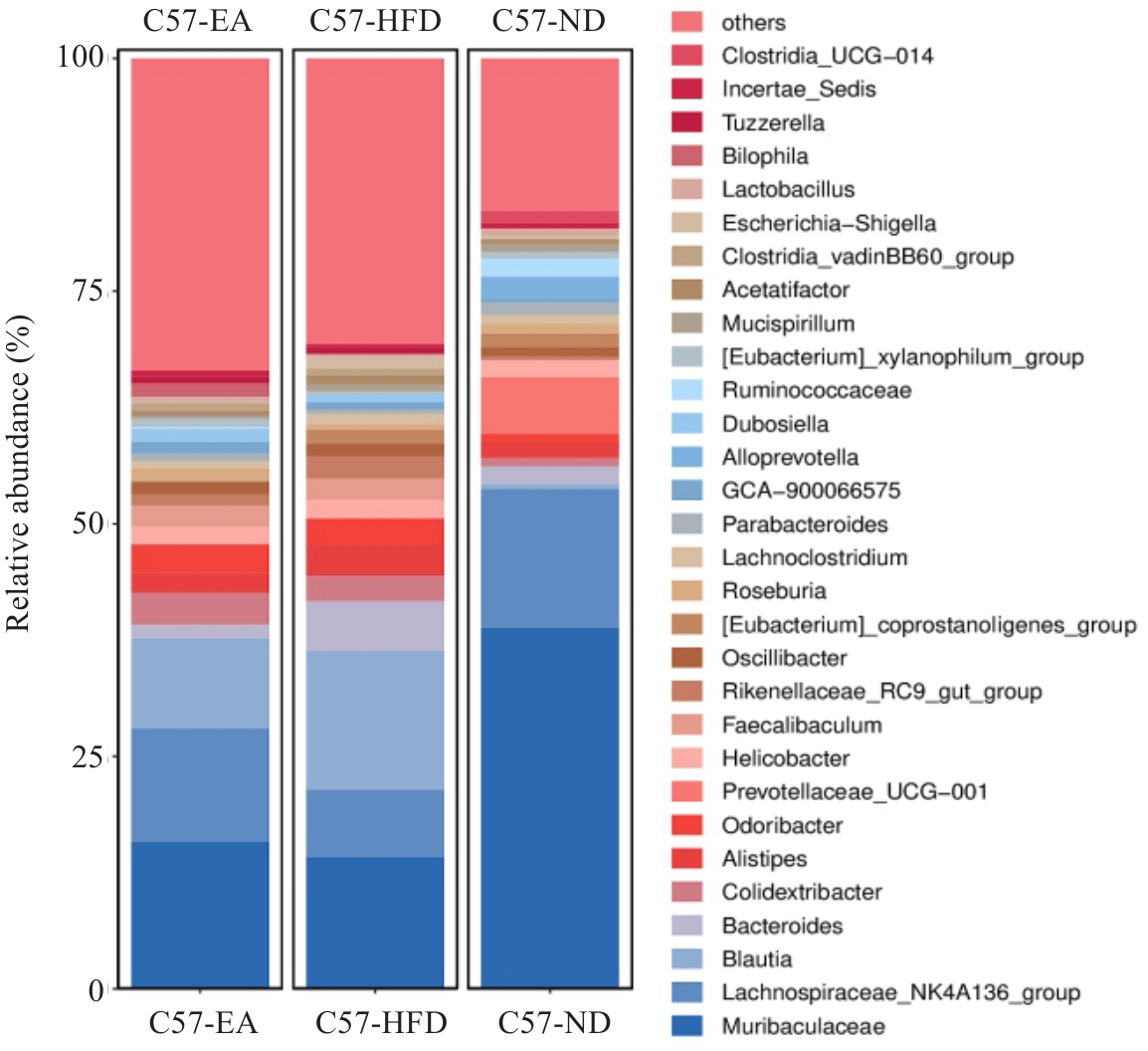
图11 菌群组成分析(属水平)
Fig.11 Bar chart of gut microbiota community structure at the genus level. ND:Normal diet group; HFD: High fat diet group; EA: High fat diet and electroacupuncture group.
| [1] | Fan S, Chen S, Lin L. Research progress of gut microbiota and obesity caused by high-fat diet[J]. Front Cell Infect Microbiol, 2023, 13: 1139800. doi:10.3389/fcimb.2023.1139800 |
| [2] | Frazier K, Kambal A, Zale EA, et al. High-fat diet disrupts REG3γ and gut microbial rhythms promoting metabolic dysfunction[J]. Cell Host Microbe, 2022, 30(6): 809-23.e6. doi:10.1016/j.chom.2022.03.030 |
| [3] | Tong Y, Gao H, Qi Q, et al. High fat diet, gut microbiome and gastrointestinal cancer[J]. Theranostics, 2021, 11(12): 5889-910. doi:10.7150/thno.56157 |
| [4] | Sanmiguel C, Gupta A, Mayer EA. Gut microbiome and obesity: a plausible explanation for obesity[J]. Curr Obes Rep, 2015, 4(2): 250-61. doi:10.1007/s13679-015-0152-0 |
| [5] | Yao XT, Yang CX, Jia XR, et al. High-fat diet consumption promotes adolescent neurobehavioral abnormalities and hippocampal structural alterations via microglial overactivation accompanied by an elevated serum free fatty acid concentration[J]. Brain Behav Immun, 2024, 119: 236-50. doi:10.1016/j.bbi.2024.04.005 |
| [6] | Le Chatelier E, Nielsen T, Qin J, et al. Richness of human gut microbiome correlates with metabolic markers[J]. Nature, 2013, 500(7464): 541-6. |
| [7] | Asadi A, Shadab Mehr N, Mohamadi MH, et al. Obesity and gut-microbiota-brain axis: a narrative review[J]. J Clin Lab Anal, 2022, 36(5): e24420. doi:10.1002/jcla.24420 |
| [8] | Ding S, Chi MM, Scull BP, et al. High-fat diet: bacteria interactions promote intestinal inflammation which precedes and correlates with obesity and insulin resistance in mouse[J]. PLoS One, 2010, 5(8): e12191. doi:10.1371/journal.pone.0012191 |
| [9] | Kim KA, Gu W, Lee IA, et al. High fat diet-induced gut microbiota exacerbates inflammation and obesity in mice via the TLR4 signaling pathway[J]. PLoS One, 2012, 7(10): e47713. doi:10.1371/journal.pone.0047713 |
| [10] | Yu WF, Yin GL, Chen SW, et al. Diosgenin attenuates metabolic-associated fatty liver disease through the hepatic NLRP3 inflam-masome-dependent signaling pathway[J]. Int Immunopharmacol, 2024, 138: 112581. doi:10.1016/j.intimp.2024.112581 |
| [11] | Engin AB. Message transmission between adipocyte and macro-phage in obesity[J]. Adv Exp Med Biol, 2024, 1460: 273-95. doi:10.1007/978-3-031-63657-8_9 |
| [12] | Lan Q, Chen J, Yang Y. Chromofungin mitigates free fatty acids-induced endothelial inflammation via inhibition of NOD-like receptor thermal protein domain-associated protein 3 mediated by adenosine 5'-monophosphate-activated protein kinase[J]. Biotechnol Appl Biochem, 2025, 72(2): 460-8. doi:10.1002/bab.2676 |
| [13] | Rajamanickam V, Desouza CV, Castillo RT, et al. Blocking thrombo-xane-prostanoid receptor signaling attenuates lipopolysaccharide- and stearic acid-induced inflammatory response in human PBMCs[J]. Cells, 2024, 13(16): 1320. doi:10.3390/cells13161320 |
| [14] | Ciesielska A, Matyjek M, Kwiatkowska K. TLR4 and CD14 trafficking and its influence on LPS-induced pro-inflammatory signaling[J]. Cell Mol Life Sci, 2021, 78(4): 1233-61. doi:10.1007/s00018-020-03656-y |
| [15] | Zhang SY, Xu QP, Shi LN, et al. Soluble CD4 effectively prevents excessive TLR activation of resident macrophages in the onset of sepsis[J]. Signal Transduct Target Ther, 2023, 8(1): 236. doi:10.1038/s41392-023-01438-z |
| [16] | Jia CW, Xiang ZQ, Zhang PF, et al. Selenium-SelK-GPX4 axis protects nucleus pulposus cells against mechanical overloading-induced ferroptosis and attenuates senescence of intervertebral disc[J]. Cell Mol Life Sci, 2024, 81(1): 49. doi:10.1007/s00018-023-05067-1 |
| [17] | 余晨歌, 黄 晶, 席艳, 等. 单纯高脂饮食诱导2型糖尿病小鼠模型的构建及病理改变的评价 [J]. 生理学报, 2024, 76(03): 385-93. |
| [18] | Duan Y, Zeng L, Zheng C, et al. Inflammatory links between high fat diets and diseases[J]. Front Immunol, 2018, 9: 2649. doi:10.3389/fimmu.2018.02649 |
| [19] | 伊丽米古丽·阿卜杜扎伊尔. 温针灸足三里对高血脂症血脂影响的临床分析[J]. 中西医结合心血管病电子杂志, 2016, 4(22): 156. |
| [20] | 兰彩莲, 万 隆, 萨喆燕, 等. 电针足三里和丰隆对高脂血症新西兰兔血脂影响[J]. 辽宁中医药大学学报, 2016, 18(10): 85-7. doi:10.13194/j.issn.1673-842x.2016.10.025 |
| [21] | 汪 倩, 陈以国. 丰隆与足三里联合异功降脂饮对血脂异常的协同增效作用[J]. 湖北中医杂志, 2020, 42(4): 21-3. |
| [22] | 邢海辉, 圣海蓉, 王玲玲. 足三里调脂作用临床研究[J]. 吉林中医药, 2009, 29(12): 1058-60. doi:10.3969/j.issn.1003-5699.2009.12.027 |
| [23] | Taha MM, Abdelghany AI, Draz RS. Lipid profile response to electroacupuncture in non-alcoholic fatty liver patients with hyperlipidemia[J]. J Acupunct Meridian Stud, 2021, 14(1): 21-6. doi:10.51507/j.jams.2021.14.1.21 |
| [24] | Zhu LL, Wei WM, Zeng ZH, et al. Impact of electro-acupuncture on lipid metalolism in rats with non-alcoholic fatty liver disease[J]. Sichuan da Xue Xue Bao Yi Xue Ban, 2012, 43(6): 847-50. |
| [25] | Xu Q, Wu HX, Zhu HB, et al. Grain-sized moxibustion at Zusanli (ST36) promotes hepatic autophagy in rats with hyperlipidemia by regulating the ULK1 and TFEB expression through the AMPK/mTOR signaling pathway[J]. Heliyon, 2023, 9(5): e15316. doi:10.1016/j.heliyon.2023.e15316 |
| [26] | 刘云龙, 李姗姗, 杨永瑞, 等. 电针“足三里” 调节胃肠功能异常的分子机制研究进展[J]. 针刺研究, 2023, 48(10): 1048-54. |
| [27] | 王 成, 袁 君, 郭彦玎, 等. 艾灸“足三里”对膝关节骨关节炎与类风湿性关节炎大鼠膝关节滑膜巨噬细胞极化的影响的比较研究 [J]. 针刺研究, 2023, 48(10): 993-1000. doi:10.13702/j.1000-0607.20220952 |
| [28] | 许 骞, 陆成轩, 吴奂汐, 等. 不同灸程45 ℃“足三里”温和灸对高脂血症大鼠腹主动脉炎性因子的影响[J]. 针刺研究, 2023, 48(9): 923-932. doi:10.13702/j.1000-0607.20221039 |
| [29] | Wang J, Zhu H, Song X, et al. Electroacupuncture regulates gut microbiota to reduce depressive-like behavior in rats[J]. Front Microbiol, 2024, 15: 1327630. doi:10.3389/fmicb.2024.1327630 |
| [30] | 吴小丽, 黄光瑞, 李晓璐, 等. 针灸调节肠道菌群研究进展[J]. 上海中医药大学学报, 2021, 35(2): 103-8. doi:10.16306/j.1008-861x.2021.02.017 |
| [31] | 赵彩娇, 谌桑妮, 李 鑫, 等. 艾灸“足三里”对衰老大鼠氧化应激和肠道菌群的影响[J]. 中国针灸, 2024, 44(3): 303-8. |
| [32] | 王婧雯, 郑淑霞, 林 晟, 等. 基于16S rDNA高通量测序研究电针对腹泻型肠易激综合征大鼠肠道菌群的调节作用[J]. 环球中医药, 2023, 16(5): 846-51. |
| [33] | 徐梦月, 白 娟, 王 强. 基于16S rDNA测序探究电针干预对自发性高血压大鼠肠道菌群的影响[J]. 中医药导报, 2023, 29(5): 6-11. |
| [34] | 蒋志明, 刘 磊, 张 辽, 等. “脑肠同调”法针刺对缺血性脑卒中患者运动功能及肠道菌群的影响[J]. 中国针灸, 2024, 44(7): 740-8. |
| [35] | Lagkouvardos I, Pukall R, Abt B, et al. Corrigendum: The Mouse Intestinal Bacterial Collection (miBC) provides host-specific insight into cultured diversity and functional potential of the gut microbiota [J]. Nat Microbiol, 2016, 1(11): 16219. doi:10.1038/nmicrobiol.2016.219 |
| [36] | Li Y, Chen M, Ma Y, et al. Regulation of viable/inactivated/lysed probiotic Lactobacillus plantarum H6 on intestinal microbiota and metabolites in hypercholesterolemic mice[J]. NPJ Sci Food, 2022, 6(1): 50. doi:10.1038/s41538-022-00167-x |
| [37] | Yan C, Huang SH, Ding HF, et al. Adverse effect of oxidized cholesterol exposure on colitis is mediated by modulation of gut microbiota[J]. J Hazard Mater, 2023, 459: 132057. doi:10.1016/j.jhazmat.2023.132057 |
| [38] | Wang X, Wang Z, Cao J, et al. Gut microbiota-derived metabolites mediate the neuroprotective effect of melatonin in cognitive impairment induced by sleep deprivation[J]. Microbiome, 2023, 11(1): 17. doi:10.1186/s40168-022-01452-3 |
| [39] | 王娇娇. 电针介导lncRNA TUG1靶向miR-127/NF-κB轴调节腹泻型肠易激综合征炎性因子的研究[D], 2022. |
| [40] | Liu S, Wang Z, Su Y, et al. A neuroanatomical basis for electroacupuncture to drive the vagal-adrenal axis[J]. Nature, 2021, 598(7882): 641-5. doi:10.1038/s41586-021-04001-4 |
| [41] | Bonaz B, Sinniger V, Pellissier S. Vagal tone: effects on sensitivity, motility, and inflammation[J]. Neurogastroenterol Motil, 2016, 28(4): 455-62. doi:10.1111/nmo.12817 |
| [42] | Zhang R, Lao L, Ren K, et al. Mechanisms of acupuncture-electroacupuncture on persistent pain[J]. Anesthesiology, 2014, 120(2): 482-503. doi:10.1097/aln.0000000000000101 |
| [43] | Tian SL, Wang XY, Ding GH. Repeated electro-acupuncture attenuates chronic visceral hypersensitivity and spinal cord NMDA receptor phosphorylation in a rat irritable bowel syndrome model[J]. Life Sci, 2008, 83(9/10): 356-63. doi:10.1016/j.lfs.2008.06.027 |
| [44] | Wu LZ, Cui CL, Tian JB, et al. Suppression of morphine withdrawal by electroacupuncture in rats: dynorphin and κ‑opioid receptor implicated[J]. Brain Res, 1999, 851(1/2): 290-6. doi:10.1016/s0006-8993(99)02069-7 |
| [45] | Zhang XN, He W, Wan HY, et al. Electroacupuncture and moxibustion-like stimulation activate the cutaneous and systemic hypothalamic-pituitary-adrenal axes in the rat[J]. Acupunct Med, 2022, 40(3): 232-40. doi:10.1177/09645284211055745 |
| [46] | Zhou F, Jiang H, Kong N, et al. Electroacupuncture attenuated anxiety and depression-like behavior via inhibition of hippocampal inflammatory response and metabolic disorders in TNBS-induced IBD rats[J]. Oxid Med Cell Longev, 2022, 2022: 8295580. doi:10.1155/2022/8295580 |
| [47] | 兰彩莲, 许金森, 萨喆燕, 等. 基于液相色谱-质谱联用技术探讨电针对高脂血症大鼠胆汁酸代谢的影响[J]. 福建中医药, 2024, 55(6): 14-20. |
| [48] | Zhao ZQ. Neural mechanism underlying acupuncture analgesia[J]. Prog Neurobiol, 2008, 85(4): 355-75. doi:10.1016/j.pneurobio.2008.05.004 |
| [49] | Koh A, De Vadder F, Kovatcheva-Datchary P, et al. From dietary fiber to host physiology: short-chain fatty acids as key bacterial metabolites[J]. Cell, 2016, 165(6): 1332-45. doi:10.1016/j.cell.2016.05.041 |
| [50] | 王婧雯. 电针足三里对IBS-D模型大鼠肠道菌群、TRPV1及相关因子的影响[D]; 福建中医药大学, 2023. |
| [51] | 楼 屹, 朱之青, 谢莉莉, 等. 电针足三里对脓毒症大鼠肠上皮细胞间紧密连接结构的影响[J]. 新中医, 2022, 54(15): 163-8. |
| [52] | 季春莲, 占靓卉, 郑静茹, 等. 电针预处理对脓毒症小鼠肠黏膜屏障功能保护作用及MLCK/MLC信号通路的调节作用[J]. 上海针灸杂志, 2023, 42(10): 1092-101. |
| [53] | 王 景, 白栓成. TLR4/NF-κB/NLRP3通路抑制炎症反应作用的研究[J]. 中国当代医药, 2024, 31(11): 180-5. |
| [54] | Zhou LL, Liu T, Huang B, et al. Excessive deubiquitination of NLRP3-R779C variant contributes to very-early-onset inflam-matory bowel disease development[J]. J Allergy Clin Immunol, 2021, 147(1): 267-79. doi:10.1016/j.jaci.2020.09.003 |
| [55] | 赵保胜, 霍海如, 姜廷良. Toll样受体4的研究及现状[J]. 中国临床药理学与治疗学, 2007, 12(1): 19-22. |
| [56] | 陈双兰, 刘 蓉, 刘青松, 等. TLR4在炎症性肠病癌变中作用机制的研究进展[J]. 中国药理学通报, 2023, 39(4): 626-30. |
| [57] | 王燕燕, 吴 瑾. TLR4在新生儿坏死性小肠结肠炎中的研究进展[J]. 临床儿科杂志, 2020, 38(11): 877-80. |
| [58] | 许文静. 肠道菌群失调在新生儿坏死性小肠结肠炎中的研究进展[J]. 中国社区医师, 2023, 39(9): 7-9. |
| [59] | 吴俊东, 耿智隆, 杨勇丽, 等. NLRP3炎症小体激活机制及其在脓毒症中的作用[J]. 医学综述, 2021, 27(3): 459-64, 470. |
| [60] | 郑沁薇, 郝微微, 王凯强, 等. NLRP3炎症小体对炎症性肠病免疫机制影响的研究进展[J]. 世界华人消化杂志, 2019, 27(6): 6. |
| [61] | 张燕燕, 陈月桥, 裴 浩, 等. 从"肝与大肠相通"理论探讨NLRP3信号通路与急性肝衰竭肠道微生态的相关性[J]. 辽宁中医药大学学报, 2024, (4). |
| [62] | 蔡燕. NLRP3炎症小体在重症急性胰腺炎小鼠肠粘膜屏障功能障碍中的作用[D], 南昌大学, 2018. |
| [63] | Epstein AA, Janos SN, Menozzi L, et al. Subventricular zone stem cell niche injury is associated with intestinal perforation in preterm infants and predicts future motor impairment[J]. Cell Stem Cell, 2024, 31(4): 467-83. e6. doi:10.1016/j.stem.2024.03.001 |
| [64] | 丁晓蕊. 萝卜硫素通过Nrf2抑制NLRP3/IL-1β轴减轻溃疡性结肠炎的炎症反应[D]. 滨州: 滨州医学院, 2019. |
| [65] | 许 骞, 刘力源, 张荣贤, 等. 基于mTOR/HIF-1α/VEGF信号通路探讨麦粒灸“足三里” 对高脂饮食大鼠血管损伤和氧化应激的影响[J]. 中国针灸, 2024, 44(4): 433-40. |
| [66] | Kim YW, Byzova TV. Oxidative stress in angiogenesis and vascular disease[J]. Blood, 2014, 123(5): 625-31. doi:10.1182/blood-2013-09-512749 |
| [67] | 苏世杰, 林东新, 刘壮壮,等. 基于AMPK/SIRT1/PGC-1α通路探讨泽泻汤改善高脂饮食诱导小鼠认知障碍的作用机制[J]. 中华中医药杂志, 2023, 38(9): 4154-60. |
| [68] | 郑晓清, 魏 伟, 李惠红, 等. 泽泻汤对高热量饮食诱导认知功能损害模型小鼠的认知功能及脑组织神经炎症的影响[J]. 中医杂志, 2024, 65(4): 395-403. |
| [1] | 王堃, 左海燕, 张娇娇, 吴欣, 王文慧, 吴生兵, 周美启. 电针通过调控海马谷氨酸释放抑制HPA轴亢进从而改善急性心肌缺血大鼠的心肌损伤[J]. 南方医科大学学报, 2025, 45(8): 1599-1607. |
| [2] | 范正媛, 沈子涵, 李亚, 沈婷婷, 李高峰, 李素云. 补肺益肾方对香烟烟雾提取物诱导的人支气管上皮细胞损伤的保护作用及其机制[J]. 南方医科大学学报, 2025, 45(7): 1372-1379. |
| [3] | 周海忆, 何斯怡, 韩瑞芳, 关永格, 董丽娟, 宋阳. 艾灸通过调控miR-223-3p/NLRP3焦亡通路修复薄型子宫内膜[J]. 南方医科大学学报, 2025, 45(7): 1380-1388. |
| [4] | 黄凯悦, 齐景馨, 罗文谦, 林怡萱, 陈梅妹, 甘慧娟. 温胆汤通过调控肠道菌群-胆汁酸轴改善代谢综合征痰证大鼠的代谢表型[J]. 南方医科大学学报, 2025, 45(6): 1174-1184. |
| [5] | 田芷华, 杨青青, 陈欣, 张方方, 钟柏茂, 曹虹. 精胺抑制巨噬细胞中GBP5介导的NLRP3炎性小体活化减轻感染肠道病毒71型的新生小鼠脏器损伤[J]. 南方医科大学学报, 2025, 45(5): 901-910. |
| [6] | 张安邦, 孙秀颀, 庞博, 吴远华, 时靖宇, 张宁, 叶涛. 电针预处理通过调节肠道-大脑轴及Nrf2/HO-1信号通路抑制铁死亡减轻大鼠脑缺血再灌注损伤[J]. 南方医科大学学报, 2025, 45(5): 911-920. |
| [7] | 卞芬兰, 倪诗垚, 赵鹏, 戚毛男星, 唐碧, 王洪巨, 康品方, 刘进军. 积雪草苷通过抑制NLRP3炎症体介导的细胞焦亡减轻大鼠心肌缺血再灌注损伤[J]. 南方医科大学学报, 2025, 45(5): 977-985. |
| [8] | 梁晓涛, 熊一凡, 刘雪琪, 梁小珊, 朱晓煜, 谢炜. 活血疏风颗粒通过抑制TLR4/NF-κB通路改善慢性偏头痛小鼠的中枢敏化[J]. 南方医科大学学报, 2025, 45(5): 986-994. |
| [9] | 孙亚磊, 罗萌, 郭长胜, 高静, 苏凯奇, 陈立典, 冯晓东. 穗花杉双黄酮通过抑制细胞焦亡减轻小鼠急性肺损伤[J]. 南方医科大学学报, 2025, 45(4): 692-701. |
| [10] | 朱正望, 王琳琳, 赵静涵, 马瑞雪, 余雨春, 蔡庆春, 王兵, 朱平生, 苗明三. 退黄合剂通过调控法尼醇X受体抑制NLRP3炎症小体改善α-萘异硫氰酸酯诱导的大鼠胆汁淤积[J]. 南方医科大学学报, 2025, 45(4): 718-724. |
| [11] | 罗嘉纯, Sodnomjamts Batzaya, 高雪锋, 陈晶宇, 余政颖, 熊莎莎, 曹虹. Akkermansia muciniphila改善gp120转基因小鼠的肠-脑相互作用障碍[J]. 南方医科大学学报, 2025, 45(3): 554-565. |
| [12] | 刘莹, 李柏睿, 李永财, 常禄博, 王娇, 杨琳, 颜永刚, 屈凯, 刘继平, 张岗, 沈霞. 加味逍遥丸通过神经递质调节、抗炎抗氧化及肠道菌群调控改善大鼠的抑郁样行为[J]. 南方医科大学学报, 2025, 45(2): 347-358. |
| [13] | 李明远, 张玮, 华梦晴. 甲基巴多索龙通过抑制NLRP3炎症小体活化缓解小鼠急性肝损伤[J]. 南方医科大学学报, 2024, 44(9): 1662-1669. |
| [14] | 肖林雨, 段婷, 夏勇生, 陈悦, 孙洋, 许轶博, 徐磊, 闫兴洲, 胡建国. 蒙花苷通过抑制TLR4/NF-κB通路抑制小鼠脊髓损伤后小胶质细胞活化介导的神经炎症和神经元凋亡[J]. 南方医科大学学报, 2024, 44(8): 1589-1598. |
| [15] | 陶怀祥, 骆金光, 闻志远, 虞亘明, 苏萧, 王鑫玮, 关翰, 陈志军. STING高表达通过调控TLR4/NF-κB/NLRP3通路和影响炎症与凋亡水平促进小鼠肾脏缺血再灌注损伤[J]. 南方医科大学学报, 2024, 44(7): 1345-1354. |
| 阅读次数 | ||||||
|
全文 |
|
|||||
|
摘要 |
|
|||||